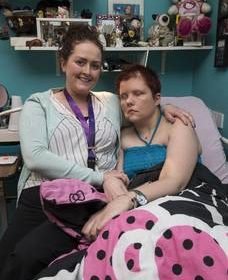'I will never give up' – Woman (35) developed this remarkable way to communicate with her family after she lost her sight and hearing

A woman battling a rare genetic condition has come up with her own, new form of communication after she lost her hearing and sight.
Petra Madill (35), from Carrickmines, Dublin, has Neurofibromatosis Type 2 (NF2), a condition that causes benign tumours to grow throughout the body, especially around the brain and the spine.
Ms Madill’s carer and close friend, Allison Farrington, described the effect of NF2.
“Sometimes these tumours produce fluid in the brain or pressure on the brain, which has caused her to lose certain things like her hearing and her sight,” she said.
Ms Madill has had 45 surgeries to limit the effects of the condition.
She is completely deaf, has only 4pc vision left in one eye and depends on the daily help of two carers.
Throughout this all, she has kept her sharp wit and humour as well as a positive outlook.
“I am determined not to let this condition beat me. I will never give up,” she said.
Ms Madill felt the first devastating effects of NF2 at age 13. In September 2016, her mother passed away from the same rare condition.
In late 2017, the sight in her remaining eye became so bad that Ms Madill, who had communicated through sign language up until this point, had to find a new way of communication.
“She struggled when her eyes were closed. I describe it as being locked in a dark box. No sight, no sound, nothing. It must have been terrifying for her,” remembered her father, Peter.
In order to not fall into isolation and to be able to keep up her active lifestyle, Ms Madill thought of a simple communication system for family, friends and medical personnel.
They spell out the words and write with the finger on Ms Madill’s cheek.
Little touches on the chin symbolise the end of words, and little sweeps in certain directions signal a quick “yes”, “no” or “maybe” to a question.
Ms Madill is able to have full conversations, understand her doctors’ questions directly and order in restaurants after having the menu “read” to her.
While the minimal sight in her eye has returned in the last year, she is still using her new communication technique in her daily life, especially when the light is less than optimal.
Even though she originally came up with her system out of necessity, Ms Madill now wants to spread the word.
“I do think this is something that could help a lot of people in similar situations,” she said.
“It is incredibly easy to learn. Everybody knows how to spell so it only takes some practice on the additional signals.”
Her carers learned the communication form in just two days.
“It was amazing to see,” added Ms Farrington.
Source: Read Full Article